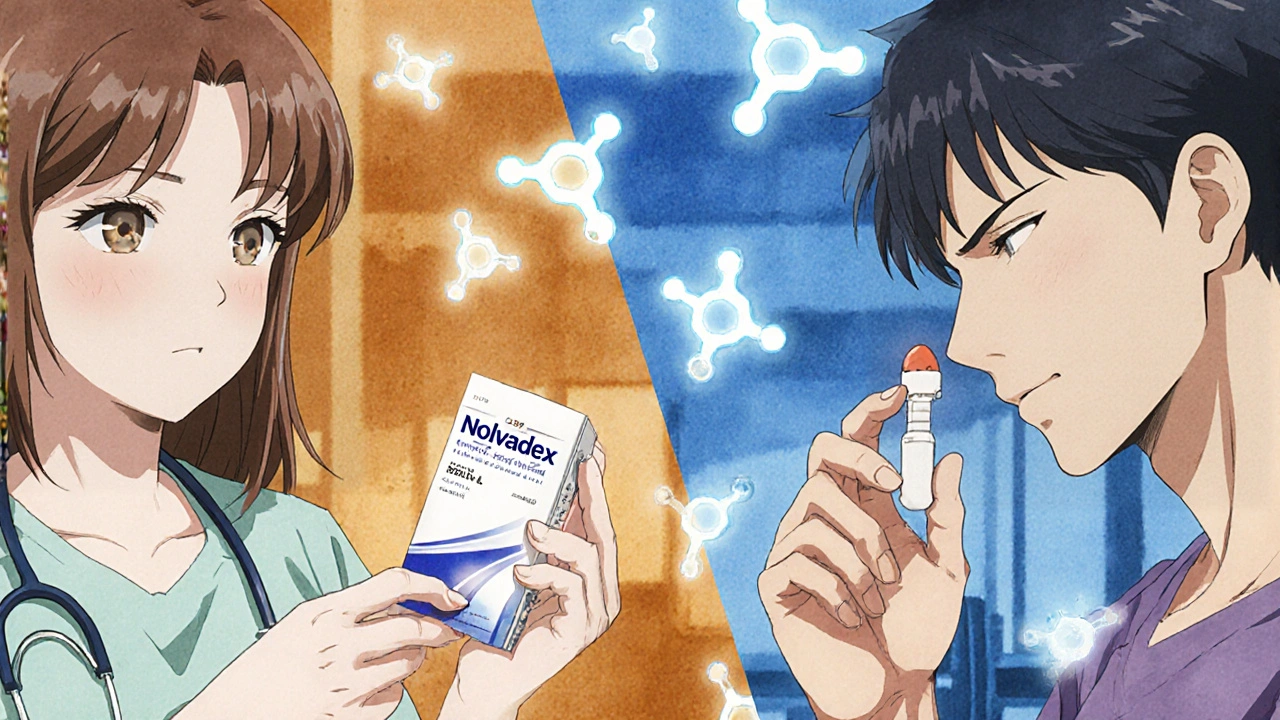Breast Cancer & PCT Drug Comparison Tool
Compare Your Situation
This tool helps you determine the most appropriate drug based on your specific medical situation. Select your situation and priority to see the best match.
Recommended Options
Select your situation and priority to see recommended drugs.
Nolvadex (tamoxifen) has been a cornerstone in breast cancer treatment and post-cycle therapy for decades. But it’s not the only option. Whether you’re a patient managing estrogen-sensitive cancer or an athlete looking to restore natural hormone balance after a steroid cycle, knowing how Nolvadex stacks up against other drugs matters. The right choice can mean fewer side effects, better results, or even improved survival rates. This isn’t about picking the ‘best’ drug-it’s about matching the right tool to your specific situation.
What Nolvadex (Tamoxifen) Actually Does
Nolvadex is a selective estrogen receptor modulator, or SERM. It doesn’t lower estrogen levels. Instead, it blocks estrogen from binding to receptors in certain tissues-especially breast tissue. That’s why it’s used to treat estrogen receptor-positive breast cancer. In men using anabolic steroids, it helps prevent gynecomastia by stopping estrogen from triggering breast tissue growth.
Unlike aromatase inhibitors, which cut estrogen production at the source, Nolvadex works like a key that fits into the estrogen lock but doesn’t turn it. It’s selective: in bones and the liver, it can actually act like estrogen, helping maintain bone density and improving cholesterol levels. That’s one reason it’s still used long-term in breast cancer patients.
Standard doses for breast cancer: 20 mg daily. For post-cycle therapy: 10-40 mg daily, tapered over 4-6 weeks. Side effects include hot flashes, mood swings, and, rarely, blood clots or uterine cancer. It’s not risk-free, but it’s been studied in over 1 million patients.
Clomid (Clomiphene Citrate): The Closest Cousin
Clomid is another SERM, often used for infertility in women and PCT in men. Like Nolvadex, it blocks estrogen receptors in the hypothalamus, which tricks the brain into producing more LH and FSH-stimulating natural testosterone production.
For PCT, many use Clomid at 50 mg daily for 2-4 weeks, then taper. Some combine it with Nolvadex. But here’s the catch: Clomid is less effective at preventing gynecomastia. It doesn’t bind as strongly to breast tissue receptors. So if you’re using it solely to avoid breast growth, Nolvadex is the better choice.
Studies show Clomid raises testosterone faster in the first two weeks of PCT, but Nolvadex sustains levels longer. A 2023 study in the Journal of Steroid Biochemistry found that 68% of men using Nolvadex alone restored normal testosterone within 6 weeks, compared to 59% using Clomid alone.
Clomid’s side effects are similar: blurred vision (rare), mood changes, headaches. It’s cheaper and often easier to find, but it’s not a direct substitute when breast tissue protection is needed.
Aromatase Inhibitors: Going Deeper Than Blockers
AIs like Arimidex (anastrozole), Letrozole, and Aromasin (exemestane) work differently. They shut down the enzyme (aromatase) that turns testosterone into estrogen. This cuts estrogen levels by 70-95%, not just blocking its effects.
In breast cancer, AIs are now first-line for postmenopausal women. They’re more effective than Nolvadex at reducing recurrence risk in this group. A 2022 meta-analysis in The Lancet Oncology showed AIs reduced breast cancer recurrence by 15% more than tamoxifen over 10 years in postmenopausal patients.
But here’s the trade-off: AIs don’t protect bone density like Nolvadex does. They can cause joint pain, bone loss, and increased cardiovascular risk. For younger women or men using steroids, using an AI alone for PCT is risky-it can crash estrogen too low, leading to fatigue, depression, and joint pain.
Many athletes use a low dose of Arimidex (0.25-0.5 mg every other day) alongside Nolvadex to control estrogen without eliminating it. That’s a hybrid approach: Nolvadex protects the breasts, Arimidex keeps estrogen from spiking.
Fareston (Toremifene): The Lesser-Known Alternative
Fareston is also a SERM, structurally similar to tamoxifen. It’s approved for metastatic breast cancer in postmenopausal women, but rarely used in the U.S. because Nolvadex is cheaper and well-established.
Studies show Fareston has similar efficacy to tamoxifen in treating breast cancer. One 2021 trial found no significant difference in survival rates between the two. But Fareston may have a slightly lower risk of blood clots and uterine cancer.
In PCT, Fareston is rarely used. It’s harder to source, more expensive, and there’s less real-world data on dosing for athletes. Some European bodybuilders swear by it, but it’s not a practical alternative for most.

Why Not Just Use Estrogen Blockers Like DIM or Calcium D-Glucarate?
You’ll see online forums pushing natural supplements like DIM (diindolylmethane) or Calcium D-Glucarate as ‘safe’ alternatives to Nolvadex. These compounds help the liver metabolize estrogen, but they don’t block estrogen receptors.
There’s zero clinical evidence that DIM prevents gynecomastia in steroid users. In one 2020 pilot study, men using DIM during a cycle still developed breast tissue at the same rate as those on placebo. For treating existing gynecomastia? Almost useless.
These supplements may help with mild estrogen imbalance in non-steroid users, but they’re not substitutes for pharmaceutical SERMs. Relying on them instead of Nolvadex during PCT or cancer treatment is dangerous.
Choosing the Right Option for Your Situation
There’s no universal ‘best’ drug. Your choice depends on:
- Are you a breast cancer patient? If you’re premenopausal, Nolvadex is still standard. If you’re postmenopausal, an AI like Arimidex is often preferred. Some switch from tamoxifen to an AI after 2-5 years.
- Are you doing PCT? For most men, Nolvadex alone works. If estrogen was high during the cycle, add a low-dose AI. Clomid can be added for a faster testosterone rebound, but it doesn’t replace Nolvadex for breast protection.
- Do you have a history of blood clots or uterine issues? Then Fareston or an AI might be safer. But only under medical supervision.
Never self-prescribe AIs for PCT. Crashing estrogen too hard can wreck your mood, libido, and joint health. Many men end up on long-term TRT because they didn’t restore natural production properly.
What About Newer Drugs Like Elacestrant or Fulvestrant?
Elacestrant is a newer oral SERD (selective estrogen receptor degrader) approved in 2023 for advanced breast cancer. It doesn’t just block estrogen-it breaks down the receptor entirely. Fulvestrant is an injectable SERD used when other drugs fail.
These are not PCT options. They’re for late-stage cancer patients who’ve exhausted tamoxifen and AIs. They’re expensive, require injections (in Fulvestrant’s case), and come with serious side effects like nausea, fatigue, and liver stress.
For 99% of people asking about alternatives to Nolvadex, these drugs are irrelevant. They’re not replacements-they’re last-resort options.

Real-World Outcomes: What Works Best?
Let’s look at what actually happens in practice:
| Drug | Primary Use | Estrogen Block Strength | Bone Protection | PCT Effectiveness | Common Side Effects |
|---|---|---|---|---|---|
| Nolvadex (Tamoxifen) | Breast cancer, PCT | High (breast tissue) | Yes | Excellent | Hot flashes, mood swings, blood clots (rare) |
| Clomid | PCT, infertility | Moderate (not breast) | No | Good (fast rebound) | Blurred vision, headaches, anxiety |
| Arimidex (Anastrozole) | Breast cancer, PCT (adjunct) | Very High (systemic) | No | Low (alone) | Joint pain, bone loss, high LDL |
| Fareston (Toremifene) | Breast cancer | High | Yes | Poor (limited data) | Nausea, hot flashes, lower clot risk |
| DIM / Calcium D-Glucarate | Supportive only | Very Low | No | None | Mild GI upset |
The data is clear: Nolvadex remains the most balanced option. It’s effective where it counts, safe for long-term use, and has decades of real-world validation. Alternatives have niches-but none replace it across the board.
Final Thoughts: When to Stick With Nolvadex
If you’re treating estrogen receptor-positive breast cancer and you’re premenopausal, Nolvadex is still the gold standard. For men recovering from a steroid cycle, it’s the most reliable tool to prevent gynecomastia and restore natural testosterone.
Don’t chase ‘better’ drugs just because they’re newer or more expensive. Clomid might give you a faster testosterone spike, but it won’t protect your chest. AIs might crush estrogen, but they’ll leave you aching and tired. Natural supplements won’t do the job.
The best choice isn’t the one with the strongest effect-it’s the one that matches your goals and risks. Nolvadex isn’t perfect, but it’s the most reliable tool in the toolbox. If you’re unsure, talk to a doctor who understands both oncology and performance medicine. Don’t guess. Your health isn’t a forum debate.
Is Nolvadex the same as Clomid?
No. Both are SERMs, but they work differently. Nolvadex blocks estrogen in breast tissue, making it essential for preventing gynecomastia. Clomid mainly stimulates testosterone production by acting on the brain. Clomid doesn’t protect the breasts effectively, so it can’t replace Nolvadex when breast tissue protection is needed.
Can I use Arimidex instead of Nolvadex for PCT?
Not alone. Arimidex lowers estrogen too much, which can cause joint pain, low libido, depression, and poor recovery. Many use a low dose of Arimidex alongside Nolvadex to control estrogen without crashing it. But Nolvadex is still required to protect breast tissue and support natural hormone rebound.
Are natural supplements like DIM effective alternatives to Nolvadex?
No. DIM and similar supplements help the liver process estrogen, but they don’t block estrogen receptors in breast tissue. Studies show they don’t prevent gynecomastia in steroid users. Relying on them instead of Nolvadex can lead to permanent breast tissue growth.
Is Nolvadex safe for long-term use?
Yes, for most people. In breast cancer patients, Nolvadex is often taken for 5-10 years. Long-term use slightly increases the risk of blood clots and uterine cancer, but the benefits usually outweigh the risks. Regular monitoring with a doctor makes it safe. It’s one of the most studied drugs in oncology.
Why do some people say Fareston is better than Nolvadex?
Fareston has a slightly lower risk of blood clots and uterine cancer, which makes it appealing for high-risk patients. But it’s more expensive, harder to get, and has less real-world data-especially for PCT. For most people, Nolvadex remains the better choice due to proven effectiveness, availability, and cost.
Next Steps: What to Do Now
If you’re considering switching from Nolvadex, start by asking: What am I trying to fix? Is it gynecomastia? Low testosterone? High estrogen symptoms? Then match the drug to the problem-not the hype.
For breast cancer patients: Talk to your oncologist about whether switching to an AI makes sense based on your menopausal status and cancer stage.
For athletes: Don’t skip Nolvadex in PCT just because it’s ‘old school.’ It’s still the most effective tool for preventing lasting side effects. Combine it with Clomid only if you need a faster testosterone boost-and always taper properly.
And never trust forum advice over clinical evidence. The people posting about ‘magic stacks’ aren’t doctors. The data is out there-use it.

